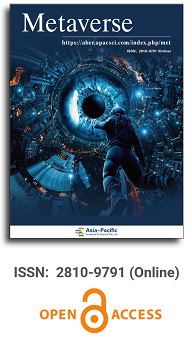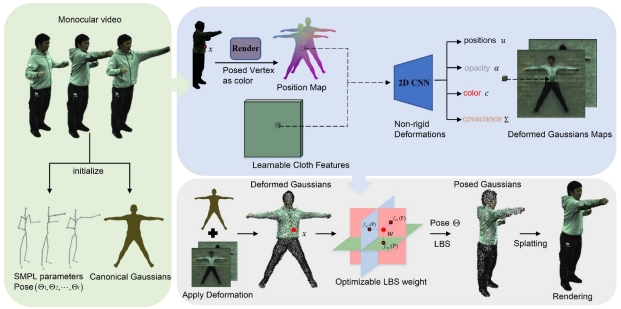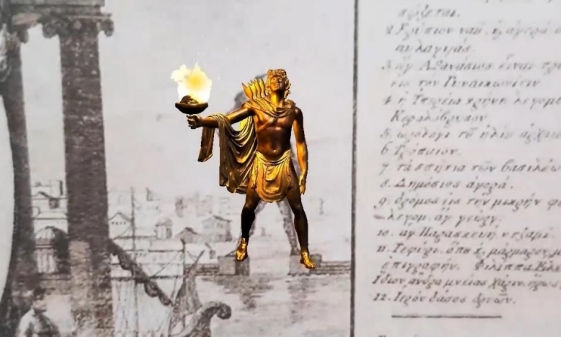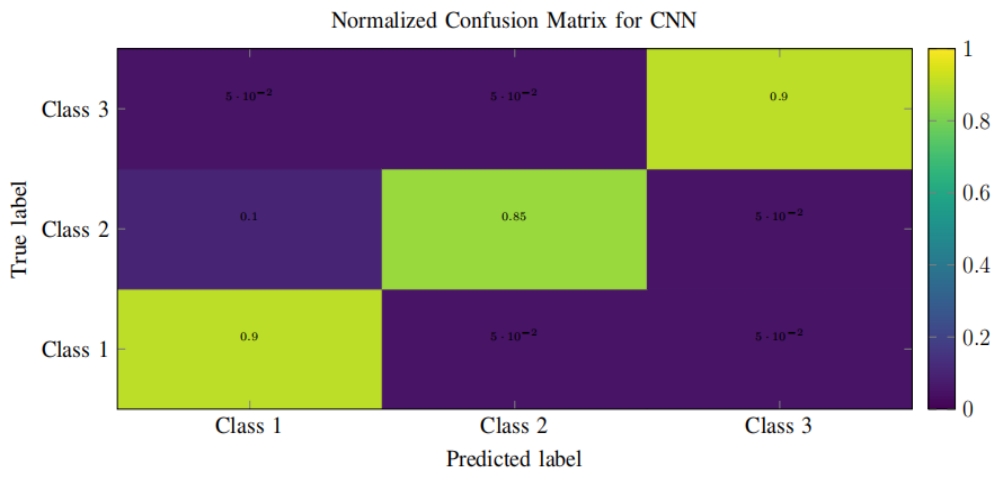
Asia Pacific Academy of Science Pte. Ltd. (APACSCI) specializes in international journal publishing. APACSCI adopts the open access publishing model and provides an important communication bridge for academic groups whose interest fields include engineering, technology, medicine, computer, mathematics, agriculture and forestry, and environment.



Exploring the Nexus: A Systematic Literature Review on Meta-Influencers in Immersive Brand Engagement
Vol 6, Issue 4, 2025
Download PDF
Abstract
Keywords
References
1. Aman Kumar and Amit Shankar. “Investigating the role of metaverse influencers’ attributes for the next generation of services”. In: Journal of Services Marketing 38.7 (2024), pp. 816–838. doi: 10.1108/JSM- 09-2023-0320.
2. Rossella C. Gambetti and Robert V. Kozinets. “From killer bunnies to talking cupcakes: Theorizing the diverse universe of virtual influencers”. In: European Journal of Marketing 58.13 (2024), pp. 205–251. doi: 10.1108/EJM-12-2022-0948.
3. Farah Mohamad Farouk Saboune. “Virtual Reality in Social Media Marketing Will Be the New Model of Advertising and Monetization”. In: Proceedings of the 9th International Conference on Social Networks Analysis, Management and Security (SNAMS). IEEE, 2022. doi: 10. 1109/SNAMS58071.2022.10062551.
4. Dogan Gursoy et al. “Metaverse in services marketing: an overview and future research directions”. In: The Service Industries Journal 43.15-16 (2023), pp. 1140–1172. doi: 10.1080/02642069.2023.2252750.
5. Matthias Eggenschwiler et al. “Retailing in the metaverse: A framework of managerial considerations for success”. In: Journal of Retailing and Consumer Services 79 (2024), p. 103791. doi: 10.1016/j. jretconser.2024.103791.
6. Nisreen Ameen, Giampaolo Viglia, and Levent Altinay. “Revolutionising services with cutting-edge technologies post major exogenous shocks”. In: The Service Industries Journal 43.3-4 (2023), pp. 125–133. doi: 10.1080/02642069.2023.2185934.
7. Garry Wei-Han Tan et al. “Metaverse in marketing and logistics: the state of the art and the path forward”. In: Asia Pacific Journal of Marketing and Logistics 35.12 (2023), pp. 2932–2946. doi: 10.1108/ APJML-01-2023-0078.
8. Mhamad Mrad, Zeyad Ramadan, and Lama I. Nasr. “Computer-generated influencers: The rise of digital personalities”. In: Marketing Intelligence & Planning 40.5 (2022), pp. 589–603. doi: 10.1108/MIP- 12- 2021- 0423.
9. M. Gulan, Y. Feng, G. F. N. Mvondo, and B. Niu. “How do virtual influencers affect consumer brand evangelism in the metaverse? The effects of virtual influencers’ marketing efforts, perceived coolness, and anthropomorphism”. In: Journal of Theoretical and Applied Electronic Commerce Research 20.1 (2025), p. 36. https://doi.org/10.3390/jtaer20010036.
10. Anna Mirowska and Jakov Arsenyan. “Sweet escape: The role of empathy in social media engagement with human versus virtual influencers”. In: International Journal of Human-Computer Studies 174 (2023), p. 103008. doi: 10.1016/j.ijhcs.2023.103008.
11. G. D. Ritterbusch and M. R. Teichmann. “Defining the Metaverse: A Systematic Literature Review”. In: IEEE Access 11 (2023), pp. 12368–12377. doi: 10.1109/ACCESS.2023.3241809.
12. Feifei Shi et al. “A New Technology Perspective of the Metaverse: Its Essence, Framework and Challenges”. In: Digital Communications and Networks (2022). https://doi.org/10.1016/j.dcan.2023.02.017.
13. D. Huang, K. K. F. So, J. Huang, and S. (S.) Huang. “Exploring the attractiveness of digital human influencers in destination marketing: The allure of two-path meaning transfer”. In: Tourism Management 110 (2025), p. 105166. https:// https://doi.org/10.1016/j.tourman.2025.105166
14. Veronica L. Thomas and Kerri Fowler. “Close Encounters of the AI Kind: Use of AI Influencers As Brand Endorsers”. In: Journal of Advertising 50.1 (2021), pp. 11–25. doi: 10.1080/00913367.2020.1810595.
15. S. Jayasingh, A. Sivakumar, and A. A. Vanathaiyan. “Artificial Intelligence influencers’ credibility effect on consumer engagement and purchase intention”. In: Journal of Theoretical and Applied Electronic Commerce Research 20.1 (2025), p. 17. https://doi.org/10.3390/jtaer20010017
16. Carlos Flavi´an, Sergio Ib´a˜nez-S´anchez, and Carlos Or´us. “The impact of virtual, augmented and mixed reality technologies on the customer experience”. In: Journal of Business Research 100 (2019), pp. 547–560. doi: 10.1016/j.jbusres.2018.10.050.
17. N. Yadav, S. Sota, and H. Chaudhary. “Applications of virtual reality in marketing (2000–2020): A 4C marketing-mix based review and future research agenda”. In: International Journal of Internet Marketing and Advertising 18.2/3 (2023), p. 121. https://doi.org/10.1504/ijima.2023.129660.
18. N. Ju, T. Kim, and H. Im. “Fake human but real influencer: The interplay of authenticity and humanlikeness in virtual influencer communication?”. In: Fashion and Textiles 11.1 (2024), p. 16. https://doi.org/10.1186/s40691-024-00380-0.
19. Li, H., Wang, Z., Liang, W. & Wang, Y. (2025). “X’s Day: Personality-Driven Virtual Human Behavior Generation.” IEEE Transactions on Visualization and Computer Graphics, vol. 31, no. 5, pp. 3514–3524.
20. K. K. W. Man, J. A. Patterson, and C. T. Simons. “Efficacy assessments of virtual reality systems for immersive consumer testing—Two case studies with tortilla chip evaluations”. In: IEEE Transactions on Human-Machine Systems 55.2 (2025), pp. 266–277. https://doi.org/10.1109/THMS.2024.3524916.
21. A. Tabassum, E. Elmahjub, A. I. Padela, A. Zwitter, and J. Qadir. “Generative AI and the metaverse: A scoping review of ethical and legal challenges”. In: IEEE Open Journal of the Computer Society 6 (2025), pp. 348–359. https://doi.org/10.1109/OJCS.2025.3536082.
22. M. Al-kfairy, A. Alomari, M. G. Al-Bashayreh, O. Alfandi, and M. Tubishat. “Unveiling the metaverse: a survey of user perceptions and the impact of usability, social influence and interoperability”. In: Heliyon 10.10 (2024), e31413. https://doi.org/10.1016/j.heliyon.2024.e31413.
23. H. Lee and C. Cho. “Virtual brand experience in digital reality advertising: conceptualization and measurement”. In: Journal of Consumer Behaviour 22.2 (2022), pp. 300–313. https://doi.org/10.1002/cb.2126.
24. H. T. Crogman, V. D. Cano, E. Pacheco, R. B. Sonawane, and R. Boroon. “Virtual Reality, Augmented Reality, and Mixed Reality in Experiential Learning: Transforming Educational Paradigms”. In: Education Sciences 15.3 (2025), p. 303. https://doi.org/10.3390/educsci15030303.
25. Esperanza Miyake. “I am a virtual girl from Tokyo: Virtual influencers, digital-orientalism and the (Im)materiality of race and gender”. In: Journal of Consumer Culture 23.1 (2023), pp. 209–228. doi: 10.1177/ 14695405221117195.
26. J. Scholz and K. Duffy. “We ARe at home: How augmented reality reshapes mobile marketing and consumer-brand relationships”. In: Journal of Retailing and Consumer Services 44 (2018), pp. 11–23. https://doi.org/10.1016/j.jretconser.2018.05.004.
27. Z. Mo and M. Zhou. “Don’t Like Them but Take What They Said: The Effectiveness of Virtual Influencers in Public Service Announcements”. In: Journal of Theoretical and Applied Electronic Commerce Research 19 (2024), pp. 2269–2288. doi: 10.3390/jtaer19030110. url: https: //doi.org/10.3390/jtaer19030110.
28. Tong (Tripp) Liu, Caroline Swee Lin Tan, and Carolina Quintero Rodriguez. “Virtual Reality in the Luxury Fashion Industry: A Systematic Literature Review”. In: Spanish Journal of Marketing - ESIC 28.2 (2024), pp. 1–18. https: //doi.org/10.1108/SJME-07-2023-0203.
29. F.Y. Lo and J.X. Peng. “Strategies for Successful Personal Branding of Celebrities on Social Media Platforms: Involvement or Information Sharing?” In: Psychology Marketing 39 (2022), pp. 320–330. https://doi.org/10.1002/mar.21667.
30. H.M. Gray, K. Gray, and D.M. Wegner. “Dimensions of Mind Perception”. In: Science 315 (2007), p. 619. https://doi.org/10.1126/science.1134475.
31. H. Hu and F. Ma. “Human-like Bots Are Not Humans: The Weakness of Sensory Language for Virtual Streamers in Livestream Commerce”. In: Journal of Retailing and Consumer Services 75 (2023), p. 103541. doi: 10.1016/j.jretconser.2023.103541.
32. F. Liu and Y.-H. Lee. “Virtually Responsible? Attribution of Responsibility toward Human vs. Virtual Influencers and the Mediating Role of Consumer Identification”. In: Journal of Business Research 153 (2023), pp. 435–447. https://doi.org/10.1016/j.jretconser.2023.103685.
33. A. Aleem, S.M.C. Loureiro, and R.G. Bilro. “Luxury fashion consumption: a review, synthesis and research agenda”. In: Spanish Journal of Marketing - ESIC 28.2 (2022), pp. 144–164. https://doi.org/10.1108/SJME-06-2021-0105.
34. Y. Na, Y. Kim, and D. Lee. “Investigating the Effect of Self-Congruity on Attitudes toward Virtual Influencers: Mediating the Effect of Emotional Attachment”. In: International Journal of Human–Computer Interaction 40.18 (2023), pp. 5534–5547. doi: 10.1080/10447318.2023. 2238365. url: https://doi.org/10.1080/10447318.2023.2238365.
35. J. Kim, M. Kim, and S.-M. Lee. “Unlocking trust dynamics: An exploration of playfulness, expertise, and consumer behavior in virtual influencer marketing”. In: International Journal of Human–Computer Interaction (2024), pp. 1–13. doi: 10.1080/10447318.2023.2300018.
36. Simone Lykke Tranholm Mouritzen, Valeria Penttinen, and Susanne Pedersen. “Virtual influencer marketing: the good, the bad and the unreal”. In: European Journal of Marketing 58.2 (2024), pp. 410–440. doi: 10.1108/EJM-12-2022-0915.
37. Yide Liu, Tao Ye, and Cheng Yu. “Virtual voices in hospitality: Assessing narrative styles of digital influencers in hotel advertising”. In: Journal of Hospitality and Tourism Management 61 (2024), pp. 281– 298. doi: 10.1016/j.jhtm.2024.11.004.
38. P. W. Stone. “Popping the (PICO) question in research and evidence-based practice”. In: Applied Nursing Research 15.3 (2002), pp. 197–198. https://doi.org/10.1053/apnr.2002.34181
39. J. P. Higgins and S. Green. Cochrane Handbook for Systematic Reviews of Interventions 4.2.6 [Updated September 2006]. Vol. 4. Updated September 2006. Chichester, UK: The Cochrane Library, 2006. Available online: www.cochrane.org/handbook (Accessed on 18 November 2024).
40. Alessandro Liberati et al. “The PRISMA statement for reporting systematic reviews and meta-analyses of studies that evaluate health care interventions: Explanation and elaboration”. In: PLoS Medicine 6.7 (2009), e1000100. doi: 10.1371/journal.pmed.1000100.
41. Reinhold Wendler. “The maturity of maturity model research: A systematic mapping study”. In: Information and Software Technology 54.12 (2012), pp. 1317–1339. doi: 10.1016/j.infsof.2012.07.007.
42. Alison Cooke, Diana Smith, and Andrew Booth. “Beyond PICO: The SPIDER tool for qualitative evidence synthesis”. In: Qualitative Health Research 22 (2012), pp. 1435–1443. doi: 10.1177/1049732312452938.
43. Andrew Booth. “Clear and present questions: Formulating questions for evidence-based practice”. In: Library Hi Tech 24 (2006), pp. 355– 368. doi: 10.1108/07378830610692127.
44. Marianne B. Eriksen and Tove F. Frandsen. “The impact of patient, intervention, comparison, outcome (PICO) as a search strategy tool on literature search quality: A systematic review”. In: Journal of the Medical Library Association: JMLA 106 (2018), p. 420. doi: 10.5195/ jmla.2018.345.
45. T. Hilken et al. “Augmenting the eye of the beholder: exploring the strategic potential of augmented reality to enhance online service experiences”. In: Journal of the Academy of Marketing Science 45.6 (2017), pp. 884–905. doi: 10.1007/s11747-017-0541-x.
46. Systematic Review Division. What are the PICO elements in systematic review? Available online: https://pubrica.com/academy/systematic-review/the-pico-framework-for-framing-systematic-review-research-questions/. (Accessed on 18 November 2024).
47. M. J. Page et al. “Updating guidance for reporting systematic reviews: Development of the PRISMA 2020 statement”. In: Journal of Clinical Epidemiology 134 (2021), pp. 103–112.
48. Covidence. “Better systematic review management”. In: (2023). Available online: https://www.covidence.org/blog/how-are-systematic-reviews-used/(accessed on 1 November 2024).
49. X. Zhang et al. “Accessibility within open educational resources and practices for disabled learners: A systematic literature review”. In: Smart Learning Environments 7 (2020), pp. 1–19.
50. A. Bilgihan, A. M. W. Leong, F. Okumus, and J. Bai. “Proposing a metaverse engagement model for brand development”. In: Journal of Retailing and Consumer Services 78 (2024), p. 103781. https://doi.org/10.1016/j.jretconser.2024.103781
51. R. Payal, N. Sharma, and Y. K. Dwivedi. “Unlocking the impact of brand engagement in the metaverse on real-world purchase intentions: Analysing pre-adoption behaviour in a futuristic technology platform”. In: Electronic Commerce Research and Applications 65 (2024), p. 101381.
52. C. Ferraro, S. Sands, V. Demsar, and J. Cohen. “Diversity representation in virtual environments: How brand motives mediate consumer perceptions”. In: Australasian Marketing Journal 32.3 (2024), pp. 239–249. https://doi.org/10.1177/14413582241244535.
53. S. Yadav, S. K. Pandey, and D. Sharma. “Marketing beyond reality: A systematic literature review on metaverse”. In: Management Research Review 47.7 (2024), pp. 1029–1051. https://doi.org/10.1108/MRR-06-2023-0456.
54. G. Liyanaarachchi, M. Mifsud, and G. Viglia. “Virtual influencers and data privacy: Introducing the multi-privacy paradox”. In: Journal of Business Research 176 (2024), p. 114584. https://doi.org/10.1016/j.jbusres.2024.114584.
55. Q. Lin, S. I. Ng, N. K. Basha, X. Luo, and Y. Li. “Impact of virtual influencers on customer engagement of Generation Z consumers: A presence perspective”. In: Young Consumers 25.6 (2024), pp. 851–868. https://doi.org/10.1108/YC-01-2024-1958.
56. B. Koles, A. Audrezet, J. G. Moulard, N. Ameen, and B. McKenna. “The authentic virtual influencer: Authenticity manifestations in the metaverse”. In: Journal of Business Research 170 (2024), p. 114325. https://doi.org/10.1016/j.jbusres.2023.114325
57. Y. Li, Z. Liu, L. Yuan, H. Tang, Y. Fan, and N. Xie. “Dynamic Scene Adjustment Mechanism for Manipulating User Experience in VR”. In: Proceedings of the IEEE Conference on Virtual Reality and 3D User Interfaces (VR) (2024), pp. 179–188. https://doi.org/10.1109/VR58804.2024.00041.
58. H.-K. Zeng and C. A. Lin. “Consumer evaluation of virtual vs. human influencers via source credibility, perceived social similarity, and consumption motivation”. In: Journal of Theoretical and Applied Electronic Commerce Research 20.3 (2025), p. 168. https://doi.org/10.3390/jtaer20030168 .
59. T. Doligalski, N. Sarna, B. Koles, A. Siejka, and R. Kozielski. “Advertising in the metaverse and its implications for brands and society: A multi-stakeholder perspective”. In: Technological Forecasting and Social Change 209 (2024), p. 123832. https://doi.org/10.1016/j.techfore.2024.123832
60. X. Cao and J. Sun. “Exploring the effect of overload on the discontinuous intention of social media users: An S-O-R perspective”. In: Computers in Human Behavior 81 (2018), pp. 10–18. https://doi.org/10.1016/j.chb.2017.11.035.
61. K. Yoo, R. Welden, K. Hewett, and M. Haenlein. “The merchants of meta: A research agenda to understand the future of retailing in the metaverse”. In: Journal of Retailing 99.2 (2023), pp. 173–192. https://doi.org/10.1016/j.jretai.2023.02.002.
62. A.K. Shelton. “Defining the lines between virtual and real-world purchases: Second life sells, but who’s buying?” In: Computers in Human Behavior 26.6 (2010), pp. 1223–1227. doi: 10.1016/j.chb.2010.03. 019.
63. E. Gadalla, K. Keeling, and I. Abosag. “Metaverse-retail service quality: a future framework for retail service quality in the 3D internet”. In: Journal of Marketing Management 29.13–14 (2013), pp. 1493–1517. doi: 10.1080/0267257X.2013.835742.
64. C. Wu. The virtual reality and augmented reality adoption impact on customer loyalty for the fashion brands. 2024. doi: 10.20944/preprints202307.1408.v3
65. S. Lim and J. Oh. “Navigating privacy: A global comparative analysis of data protection laws”. In: IET Information Security (2025). https://doi.org/10.1049/ise2/5536763
Supporting Agencies
Copyright (c) 2025 Md Golam Muttaquee Talukder, Olugbenga Akinade, Muhammad Zahid Iqbal

This work is licensed under a Creative Commons Attribution 4.0 International License.

This site is licensed under a Creative Commons Attribution 4.0 International License (CC BY 4.0).

Prof. Zhigeng Pan
Director, Institute for Metaverse, Nanjing University of Information Science & Technology, China

Prof. Jianrong Tan
Academician, Chinese Academy of Engineering, China
Conference Time
December 15-18, 2025
Conference Venue
Hong Kong Convention and Exhibition Center (HKCEC)
...
Metaverse Scientist Forum No.3 was successfully held on April 22, 2025, from 19:00 to 20:30 (Beijing Time)...
We received the Scopus notification on April 19th, confirming that the journal has been successfully indexed by Scopus...
We are pleased to announce that we have updated the requirements for manuscript figures in the submission guidelines. Manuscripts submitted after April 15, 2025 are required to strictly adhere to the change. These updates are aimed at ensuring the highest quality of visual content in our publications and enhancing the overall readability and impact of your research. For more details, please find it in sumissions...






.jpg)
.jpg)

